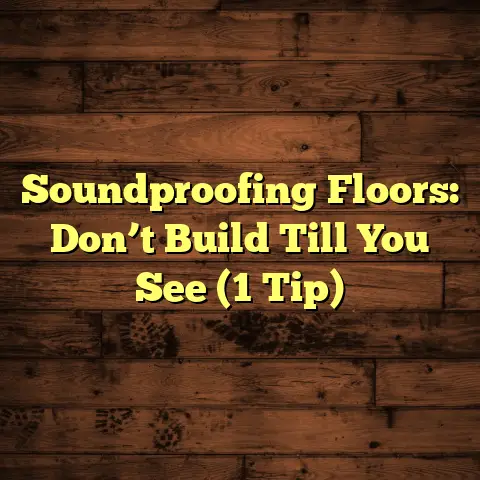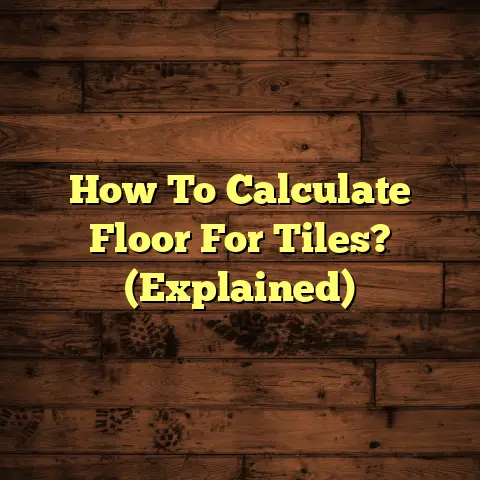Buy Chair Mats Near Me? (4 Quality Red Flags!)
Think about it: a gaming room faces different challenges than a formal conference room, right? Understanding those room-specific needs is key to choosing a chair mat that actually works. Otherwise, you might as well throw your money out the window!
In this article, I’m going to walk you through the world of chair mats. I’ll explain what they are, why they matter, and how to spot those sneaky quality red flags that can lead to flooring nightmares. So, if you’re typing “buy chair mats near me” into Google, stick around! This is for you.
Section 1: Understanding Chair Mats
Okay, let’s start with the basics. What is a chair mat? Simply put, it’s a protective barrier between your chair (usually one with wheels) and your floor. Its main purpose is twofold:
-
Protecting your flooring: Rolling chairs can wreak havoc on floors, especially hardwood, laminate, and even some carpets. A chair mat prevents scratches, dents, and wear patterns.
-
Enhancing mobility: A good chair mat allows your chair to glide smoothly, reducing strain and improving your overall comfort.
Now, there’s a whole universe of chair mats out there. Here are some common types:
-
Materials:
-
Polycarbonate: These are generally considered the crème de la crème. They’re durable, transparent, and resistant to cracking.
-
Vinyl: A more budget-friendly option. But be careful! Low-quality vinyl can be prone to warping and cracking.
-
PVC (Polyvinyl Chloride): Another common choice. It’s inexpensive, but can be less durable and may emit odors.
-
Tempered Glass: A premium choice that offers exceptional durability and style. It is scratch-resistant and suitable for heavy use.
-
-
Sizes and Shapes: Rectangular, round, square, with or without a lip (the extended part that goes under your desk) – the options are endless!
-
Compatibility: Some mats are designed for hard floors, while others are specifically made for carpets. You need to choose the right one!
Speaking of compatibility, consider the type of chair you have. A heavy-duty rolling chair will require a more robust mat than a stationary task chair. And, of course, the flooring itself is a huge factor. More on that in the next section.
Section 2: Room-Specific Needs
This is where things get interesting. The best chair mat for your home office might be a terrible choice for a conference room. Let’s break it down by room type.
-
Home Office:
-
Durability: You’re probably spending a lot of time in your home office, so the mat needs to hold up.
-
Aesthetics: Let’s be honest, you want something that looks good! Clear polycarbonate is a popular choice because it lets your flooring shine through.
-
Slip Resistance: Safety first! Make sure the mat has a non-slip backing to prevent it from sliding around on hardwood or tile. I’ve seen some nasty falls!
-
-
Conference Rooms:
-
Size Matters: Conference rooms often have large tables and multiple chairs. You’ll need a correspondingly large mat to allow for easy movement.
-
Transparency: A clear mat keeps the focus on the meeting, not the floor covering.
-
Heavy-Duty: Conference room chairs tend to be heavier and used more frequently than home office chairs. Choose a mat that can handle the weight.
-
-
Gaming Rooms:
-
Comfort: Gamers can spend hours glued to their screens. A mat with extra cushioning or anti-fatigue properties can make a big difference.
-
Durability: Spills happen! Look for a mat that’s easy to clean and resistant to stains.
-
Size: Depending on your setup, you might need a larger mat to accommodate your chair’s range of motion.
-
-
Dining or Living Areas:
-
Decor: In these spaces, the mat needs to blend in with your existing décor. Consider decorative options or mats that complement your flooring.
-
Functionality: Protecting your floors from chair legs is still important, even in a dining or living area.
-
Material: Opt for materials that are easy to clean and maintain, especially in areas prone to spills.
-
Real-World Example: I once had a client who insisted on using the same thin vinyl chair mat in their home office (hardwood floor) and their conference room (low-pile carpet). In the office, the mat slid around constantly, and the hardwood started to show scratches. In the conference room, the mat was too small and didn’t provide enough protection. A simple switch to room-specific mats solved both problems!
Section 3: Quality Red Flags to Look For
Okay, so you know what a chair mat is and what you need it for. Now, how do you avoid getting ripped off? This is where those quality red flags come in. When you search “buy chair mats near me,” don’t just grab the first thing you see!
Choosing a low-quality mat can lead to a whole host of problems: warping, cracking, poor performance, and ultimately, damage to your floors. Let’s dive into the specifics.
Red Flag #1: Material Quality
As I mentioned earlier, the material of a chair mat is crucial. Low-quality materials can lead to a number of issues.
-
PVC Problems: Cheap PVC mats are notorious for warping, yellowing over time, and emitting unpleasant odors (especially when new). I’ve even seen some that become brittle and crack easily.
-
Vinyl Vulnerabilities: Low-grade vinyl is susceptible to cracking and tearing, especially under heavy use. It might seem like a good deal at first, but you’ll end up replacing it much sooner.
-
Polycarbonate Pretenders: Be wary of mats that claim to be polycarbonate but feel flimsy or have a cloudy appearance. True polycarbonate is incredibly durable and crystal clear.
Industry Insight: I always recommend polycarbonate mats, even though they’re a bit more expensive. In my experience, they last much longer and provide superior protection. Think of it as an investment in your floors.
Red Flag #2: Thickness and Density
Thickness and density are key indicators of a chair mat’s ability to protect your floors and provide smooth rolling.
-
Too Thin = No Protection: A mat that’s too thin won’t provide adequate cushioning or support. Your chair wheels will sink into the floor, and you’ll likely see damage over time.
-
Density Deficiency: A low-density mat might feel soft at first, but it will quickly compress and lose its shape. This can make rolling difficult and uneven.
-
Carpet Catastrophe: For carpets, thickness is especially important. You need a mat with “cleats” or “grippers” on the underside to hold it in place. Without them, the mat will slide around and bunch up.
Pro Tip: When shopping for a chair mat, pay attention to the thickness specification. For hard floors, I recommend a minimum thickness of 0.1 inches (2.5mm). For carpets, go for at least 0.2 inches (5mm) with aggressive cleats.
Red Flag #3: Warranty and Return Policy
A reputable manufacturer will stand behind their products with a solid warranty and a reasonable return policy.
-
No Warranty = No Confidence: If a company doesn’t offer a warranty, it’s a major red flag. It suggests they don’t have much faith in the quality of their mats.
-
Limited Coverage: Be sure to read the fine print! Some warranties only cover manufacturing defects, not normal wear and tear.
-
Return Policy Restrictions: A restrictive return policy can also be a warning sign. If you can’t easily return the mat if you’re not satisfied, it’s probably best to look elsewhere.
Personal Story: I once bought a chair mat online that claimed to have a “lifetime warranty.” When the mat cracked after just a few months, I tried to file a claim. Turns out, the “lifetime” only applied to the original purchaser, and I had to pay for shipping both ways! Lesson learned: always read the warranty carefully.
Red Flag #4: Reviews and Ratings
Customer reviews and ratings can provide valuable insights into the real-world performance of a chair mat.
-
Pattern Recognition: Look for patterns of complaints or praise. Are multiple customers reporting the same issue (e.g., cracking, sliding, odor)? That’s a red flag.
-
Critical Thinking: Don’t rely solely on star ratings. Read the reviews themselves and pay attention to the details. Are the reviewers describing similar experiences?
-
Fake Reviews: Be aware that some companies may post fake reviews to boost their ratings. Look for reviews that seem overly enthusiastic or generic.
How to Spot Fake Reviews:
- Generic Language: Vague phrases like “great product” or “highly recommend” without specific details.
- Similar Writing Styles: Multiple reviews with the same sentence structure or vocabulary.
- Sudden Surge of Positive Reviews: A large number of positive reviews posted within a short period.
- No Negative Reviews: A product with only positive reviews is suspicious.
Statistical Support: According to a study by Northwestern University, approximately 36% of online reviews are fake. It’s crucial to approach online reviews with a healthy dose of skepticism.
Industry Data: A survey conducted by the Better Business Bureau found that products with a high volume of negative reviews are significantly more likely to result in customer complaints.
Critical Evaluation: Scrutinize reviews for authenticity and relevance. Look for detailed feedback that discusses both the pros and cons of the product.
Conclusion
Buying a chair mat might seem like a simple task, but as you’ve seen, there’s more to it than meets the eye. By understanding your room-specific needs and being aware of those quality red flags, you can make a more informed purchase and protect your floors for years to come.
Don’t rush the process! Take your time, do your research, and don’t be afraid to ask questions. The right chair mat can significantly improve your workspace or living area, providing both comfort and protection.
Remember, a little bit of knowledge can go a long way in preventing costly flooring repairs down the road!
Call to Action
Now it’s your turn! What are your experiences with chair mats? Have you encountered any of these red flags yourself? Share your tips and insights in the comments below! Let’s help each other make smarter purchasing decisions.





